
by KPMLAW | Apr 2, 2024 | KPMBlog, News, Profiles, Uncategorized, Updates
Written by Chris Flynn, Esq. Edited by Gary Reinhardt, Esq. A new bill in Virginia that is currently sitting on the Governor’s desk waiting to be signed has the potential to open UM/UIM carriers up to exposure for bad faith negotiations with their insured. SB 256 seeks to amend and reenact §§8.01-66.1 and 38.2-2206 of the Code of Virginia, relating to remedies for bad faith refusal of uninsured/underinsured motor vehicle insurance claims. Specifically, the Bill allows for the insured and/or the insured’s counsel to seek adjudication of a claim that the UM/UIM insurance carrier did not act in good faith by making either a posttrial motion before the court in which the underlying personal injury or wrongful death judgment was obtained or filing a separate action against the carrier. In order for the insured and/or their counsel to take such an action, the Bill sets forth certain conduct that must be alleged and that the Court must subsequently find. The new law would require the following of the UM/UIM carrier: (i) denies, refuses, fails to pay, or fails to make a timely and reasonable settlement offer to its insured under the provisions of any uninsured or underinsured motorist benefits coverage in a policy of motor vehicle insurance applicable to the insured after the insured has become legally entitled to recover, or (ii) after all applicable liability policy limits and underlying uninsured and underinsured motorists benefits have been tendered or paid, rejects a reasonable settlement demand made by the insured within the policy’s coverage limits for uninsured or underinsured motorist benefits or fails to respond within a reasonable time after...
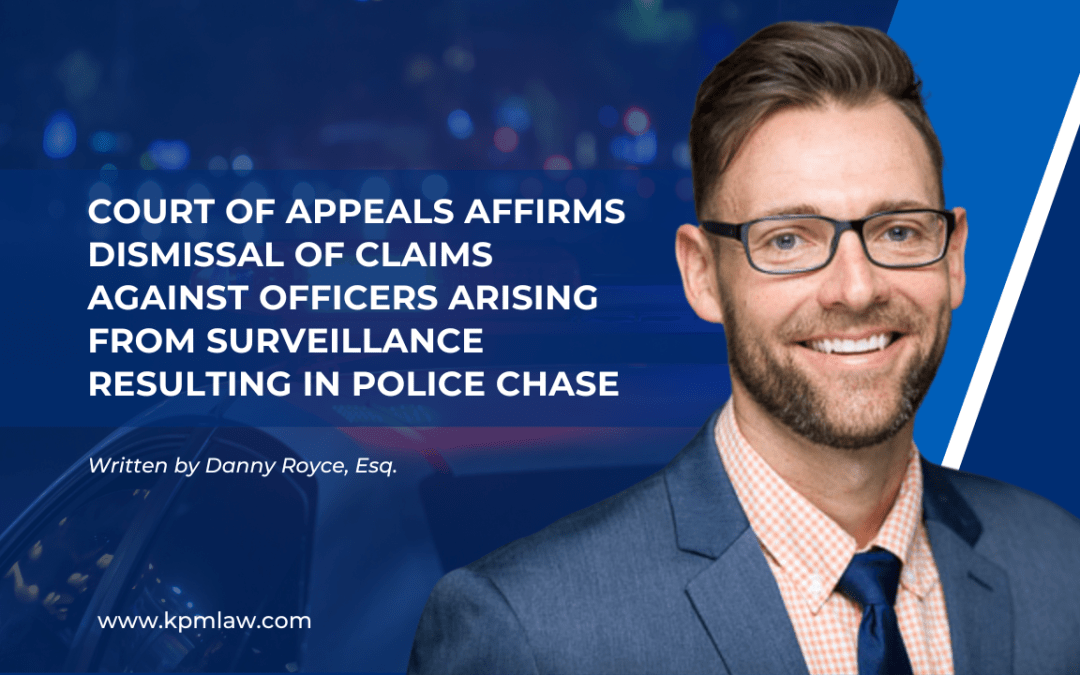
by KPMLAW | Dec 3, 2023 | KPMBlog, News, Profiles, Uncategorized
Written by Daniel Royce, Esq. On April 18, 2023, in the case of Best v. Farr, et al., 2023 Va.App. Lexis 245* (Court of Appeals of Virginia) addressing claims arising from an officer-involved shooting, the Court of Appeals ruled the trial court properly dismissed claims of gross negligence, willful, wanton, and reckless negligence, battery, and that the Arlington County Police Chief was grossly negligent in supervision of a police operation carried out by officers under his command. At issue were events arising from an Arlington County Police tactical unit stopping a vehicle for suspected criminal activity. Police efforts were resisted, which led to violence and injury to the appellants. Appellants filed nearly identical civil complaints alleging joint and several liability against defendants/appellees under multiple counts.[1] Defendants filed demurrers which were sustained without leave to amend. This appeal followed, and the Court reviewed the lower court rulings de novo.[2] Facts and Background On May 3, 2018, Appellants Best and Lary (“Appellants”) were occupants of a van being surveilled by police under authority of Police Chief Farr. Lary had an outstanding warrant for her arrest.[3] A team of Arlington Police officers observed a transaction between Best and a third party which appeared to involve illegal drugs. After the transaction, Best parked his vehicle on a public street near an intersection. The police surrounded Best’s vehicle with unmarked police vehicles. Four armed, plain clothes officers approached the van. On of the officer’s approached Best’s window. No badges were displayed, nor were the appellants told they were under arrest. The officer closest to the window told Best to show him his hands. In...
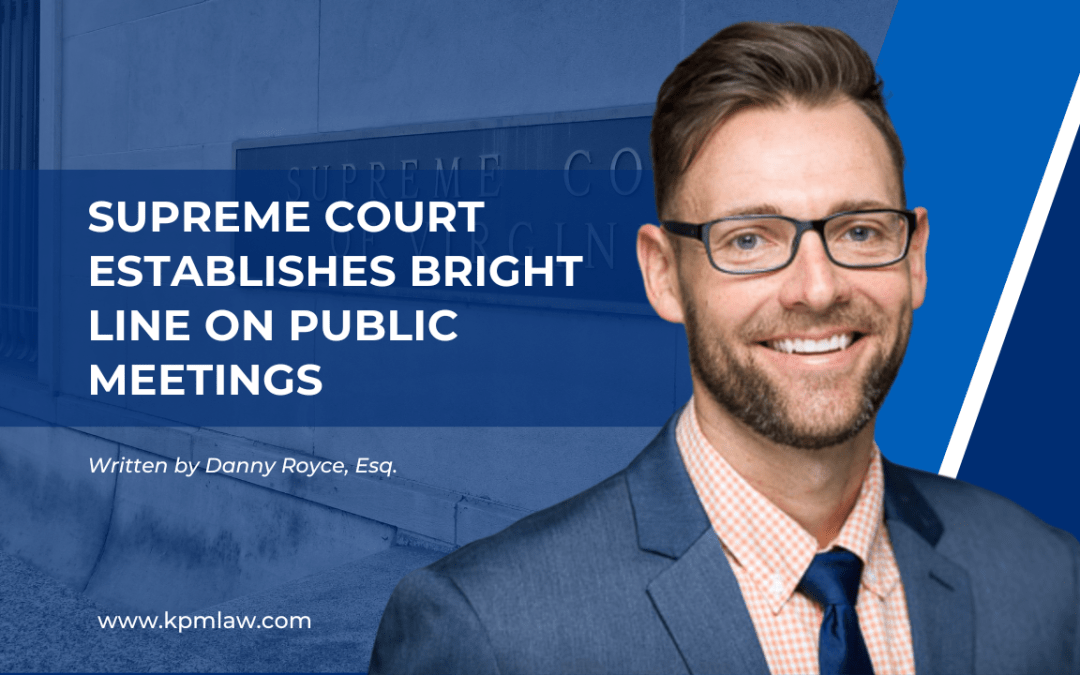
by KPMLAW | Aug 31, 2023 | Court, KPMBlog, News, Profiles, Uncategorized
In May of 2023, the Supreme Court of Virginia ruled on a Freedom of Information Act (FOIA) case, and in so doing, established a bright line which will likely have a significant impact on public entities and “public meetings”. The matter of B. Alan Gloss, Et Al. v. Ann B. Wheeler, Et Al. (Record No. 210779) established a more expansive definition of what constitutes a public meeting of government officials.[1] Facts and Background The underlying facts revolve around an impromptu meeting of the Prince William Board of Supervisors in May 2020 in which members discussed local unrest in the wake of the George Floyd killing. Several residents of the County filed a “Petition for Mandamus and Injunction” in Prince William Circuit Court alleging that five members of the Board of Supervisors knowingly and willfully violated Virginia FOIA (VFOIA) by attending a meeting as defined by VFOIA without complying with statutory requirements of the act. On May 25, 2020, George Floyd was killed in police custody in Minneapolis, Minnesota. His death ignited nationwide protests including a protest in Prince William County on May 30, 2020. The protest began peacefully, but subsequently turned violent. An “unlawful assembly” was declared at approximately 8:00 p.m., but the group of protestors continued to grow in number. Events escalated and included acts of vandalism and violence. County officials began characterizing the events as “riots”. At approximately 10:00 p.m., police officials sent an email to members of the Board of Supervisors providing information about the unrest. Board members were advised that police were attempting to regain order, and portions of roads within the county remained closed. ...
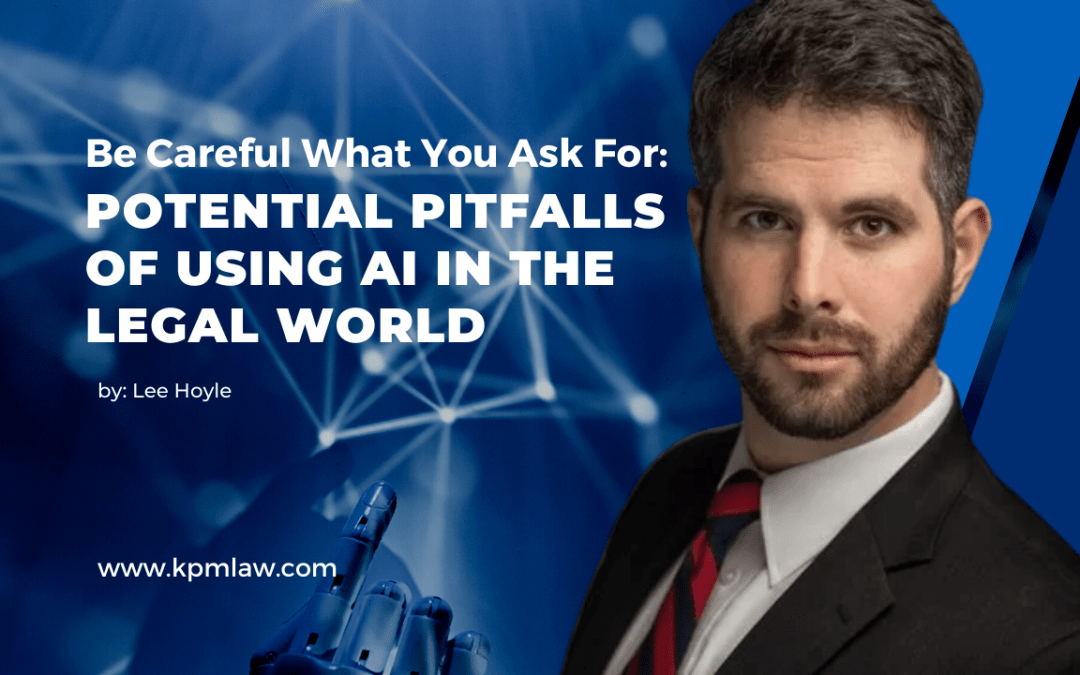
by KPMLAW | Aug 18, 2023 | KPMBlog, News, Uncategorized
Written by Lee Hoyle, Esq. Edited by Bill Pfund, Esq. Artificial intelligence has gone from the realm of science fiction to a consumer product with the release of ChatGPT and other large language models. Proponents of AI have touted their ability to revolutionize any number of industries, including the legal profession. These optimistic claims may overlook potential pitfalls in using the new technology professionally, particularly in legal realm. One lawyer found out the hard way that AI might not be what it seems at first blush. Before using AI in any professional capacity, an attorney must have a basic understanding how large language models work. AI typically refers to large language model programs. At the risk of oversimplification, these programs operate as highly refined predictive text generators. AI or large language model programs have gone from predicting the next word to predicting the correct response, even where the correct response is a sentence, a paragraph, or even pages of text. Critically, these programs have been trained to provide the correct response through processing and evaluating huge amounts of text. By training the programs on massive amounts of text, the programmers are able to teach the program to analyze questions from users and provide responses based on the training texts. This reliance on training texts presents a potential problem for lawyers and other professionals in the legal field who are required to keep certain information confidential. Obtaining a useful response from AI might require providing key details specific to a given case. Giving those details might allow the AI to provide a more helpful response, but it might also unintentionally...
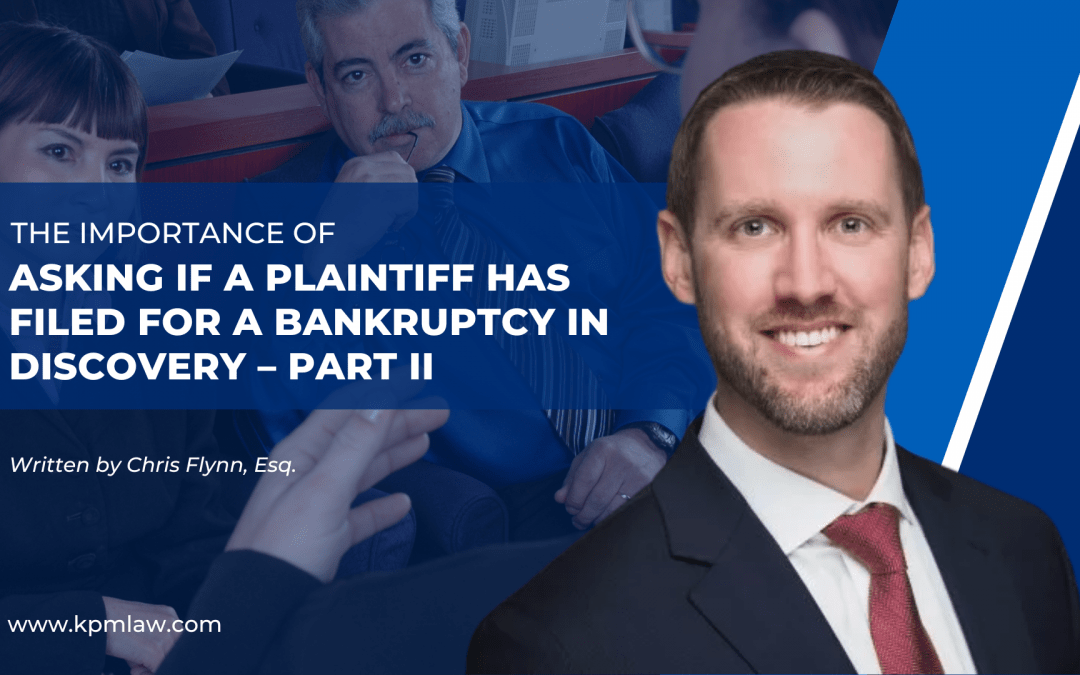
by KPMLAW | Apr 25, 2023 | KPMBlog, News, Profiles, Uncategorized, Updates
Written by Chris Flynn, Esq. Edited by Bill Pfund, Esq. An earlier article addressed two reasons why asking if a plaintiff has filed for bankruptcy during discovery is an overlooked but important question. Those reasons are to raise the issue of the admissibility of the debtor-plaintiff’s medical bills as well as to challenge the standing of that debtor-plaintiff in the non-bankruptcy matter. The question of standing however is exclusive to Chapter 7 debtor-plaintiffs (see Wilson v. Dollar General Corp., 717 F3 337, 343-44 (4th Cir. 2013)). Therefore, aside from challenging the admissibility of the debtor-plaintiff’s medical bills, is there any challenge that can be raised when a plaintiff in a non-bankruptcy matter has filed a Chapter 13 bankruptcy case? The answer is, yes. Judicial estoppel is a legal defense used for early dismissal of cases brought by bankrupt plaintiffs. In a bankruptcy, judicial estoppel applies if a debtor-plaintiff omits any claim that the plaintiff knew of at the time of filing for bankruptcy or learned of while the bankruptcy case was pending. If a defendant succeeds in establishing judicial estoppel, the plaintiff is barred from pursuing a case regardless of the claim’s merits. The Fourth Circuit has held that judicial estoppel applies when: (1) the party to be estopped is advancing an assertion that is inconsistent with a position taken during previous litigation, (2) the position is one of fact instead of law; (3) the prior position was accepted by the court in the first proceeding; and (4) the party to be estopped has acted intentionally and not inadvertently. Folio v. City of Clarksburg, 134 F.3d 1211, 1217 (4th...
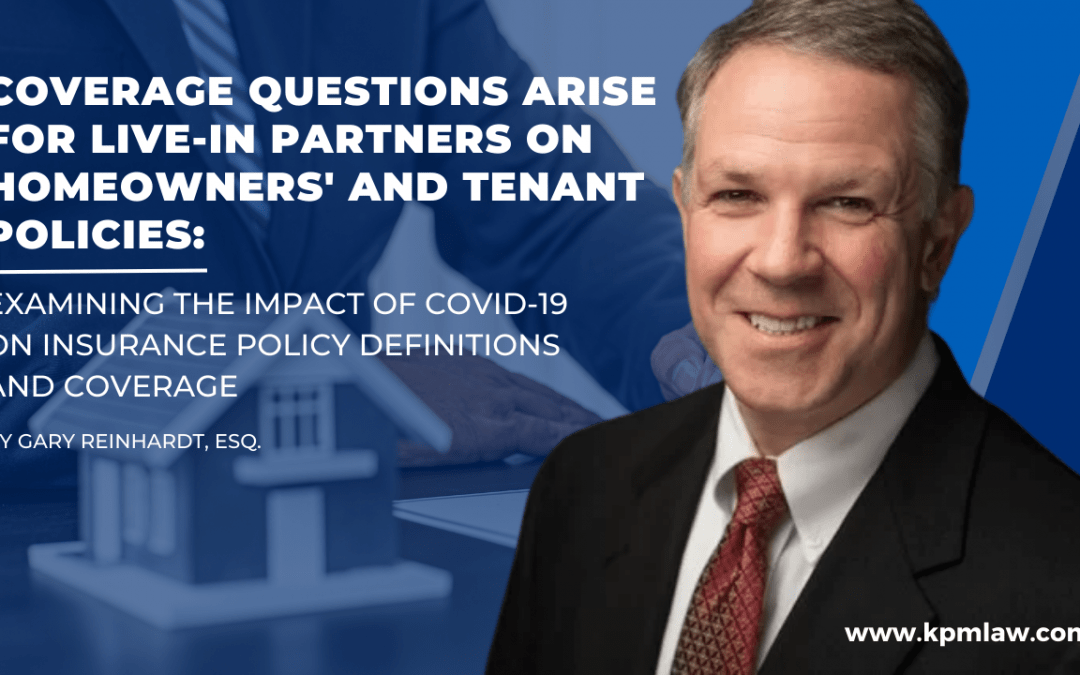
by KPMLAW | Mar 14, 2023 | Covid, KPMBlog, News, Profiles, Uncategorized, Updates
Written by Gary Reinhardt, Esq. As we enter the “endemic” phase of COVID-19, many things changed in our society. For instance, after a couple of years of being isolated, it seems people want to gather more. Further, with the multi-year moratorium on indoor weddings caused by the pandemic, the rush to book those venues created a logjam for the foreseeable future, pushing back planned matrimonial bliss. These situations result in even more living together arrangements. As for insurance, how does this situation impact who qualifies as an “insured” in a homeowners’ or tenant policy and along with that, who has coverage? For example, consider an insured with a live-in girlfriend. Suppose she is not on a lease or deed (and moved in after application, to avoid the easy argument of rate evasion). An insured may attempt coverage for his girlfriend in two aspects, either by claiming she is “family” or a “family member” or invoking the “personal property of others” clause. Initially, the typical policy requires for coverage that “The personal property must be owned or used by you, or your family members who reside with you . . .” What happens when a person, not the named insured (“you”), suffers a loss of his/her exclusive property like clothes or some sort of family heirloom? Many property insurance policies do not define “family member.” However, auto policies, like the standard specimen policy posted to its website by the Virginia Bureau of Insurance, does: “Family member” means a person related to you by blood, marriage or adoption who is a resident of your household. This includes a ward or foster child. Likewise,...







